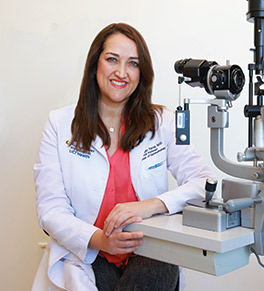Giving the gift of sight

Each year, severe eye injuries scar the eye’s surface, robbing tens of thousands of people of their sight.
The UCI Health Gavin Herbert Eye Institute is now the second medical institution in the nation and the only one on the West Coast to offer a rare vision-restoring treatment for this blinding condition.
Called ocular stem cell transplantation, the procedure involves removing scar tissue from the eye’s surface and grafting healthy donor cells from the limbus (the rim of the cornea). These limbal stem cells multiply, replacing the cornea’s tissue.
UCI Health cataract and cornea specialist Dr. Marjan Farid is one of handful of U.S. ophthalmologists able to perform this complex, sight-saving surgery. She trained with University of Cincinnati ophthalmologist Dr. Edward Holland, who devised the transplant procedure, which has restored vision for hundreds of people stricken with severe cornea damage.
Holland and his Foundation for Sight Restoration chose the Orange County eye institute to be the first of five planned U.S. centers of excellence offering this life-changing treatment. Farid, who leads the UCI Health Severe Ocular Surface Disease Program, explains the unique stem-cell transplant process.
What causes ocular surface damage?
It can result from thermal or chemical exposure, such as acid or alkali burns. About 100,000 people experience such accidents annually, often in the workplace.
Some autoimmune diseases also can burn the eye surface from the inside out. Side effects from chemotherapy and radiation therapy can cause limbal cell damage as well.
Standard therapeutics or cornea replacement cannot reverse this condition because too many of the eye surface stem cells have been destroyed.
What does the transplant involve?
The first step is to surgically remove the scar tissue, which can be an extensive process. Because the eye surface will scar again without healthy stem cells to replenish the tissue, the next step, done at the same time, is to implant donor limbal cells.
These are usually harvested from a patient’s sibling or another closely related donor who has undergone a protocol to ensure that their cells are healthy .
We also supplement with cadaver tissue that has been meticulously prepared and processed.
All this occurs prior to the transplant surgery.
Are donors at any risk?
Taking limbal cells from the eyes is a minor procedure.
Although the risk is very low, it’s still a surgery and donors need about a week to recover.
Most people are born with excess limbal cells and they regenerate after the procedure.
In a healthy donor, we can safely remove 30% to 50% of the limbus without negative consequences.
How soon do you see results?
Once we have transplanted the donor cells, we usually know within the first week or two if the limbal cells are reproducing nicely.
Results often can be dramatic because just by removing scar tissue, patients may see clearly as early as the first day.
Depending on the underlying cause of the corneal damage, some patients have as high as a 75% success rate. With older techniques, the failure rate was 90%, so this is a huge advance.
A recent patient of mine who lost the ability to live independently is now able to manage on her own. It’s very gratifying to be able to improve someone’s life in such a profound way.
Why is this procedure so successful?
Overcoming tissue rejection was the greatest challenge. Systemic immunosuppression isn’t needed for standard cornea transplants.
But Dr. Holland realized that ocular cell transplantation is essentially the same as a solid organ transplant. Like a kidney transplant, it requires the careful match patient and donor tissue as well as treatment to prevent rejection.
He not only pioneered the transplant procedure but also the surgical and postoperative patient management protocols, which includes two to four years of medication to suppress the immune system and prevent rejection.
How did you come to learn this rare procedure?
When I joined the UCI School of Medicine after completing my fellowship in corneal surgery under department chair Dr. Roger Steinert, he suggested I train in ocular stem cell transplantation in Cincinnati with his colleague, Dr. Edward Holland.
He and his team have been wonderful in helping us set up our program.
I’ve treated 40 to 50 patients with varying degrees of ocular damage over more than a decade. These complex cases take about 80 hours over the course of a year to manage, so I could only do a few annually.
Because these patients need systemic immunosuppression medications to prevent rejection, a trained team is needed to oversee their care.
We have been working with the UCI Health Kidney Transplant team, but we are now going to hire a nurse coordinator to help patients manage extensive pre- and postsurgical appointments, frequent blood and other tests, and even preparatory surgeries in some cases.
This will enable us to rev up our program and treat more patients going forward.
Why was UCI Health chosen to offer this treatment?
The Holland foundation recognizes that UCI Health has great infrastructure, a great kidney transplant team and a great ophthalmology team.
The Gavin Herbert Eye Institute also has the support of amazing donors, as well as my colleagues and our leadership, all of whom understand how this program can change people’s lives by giving them back their sight.




